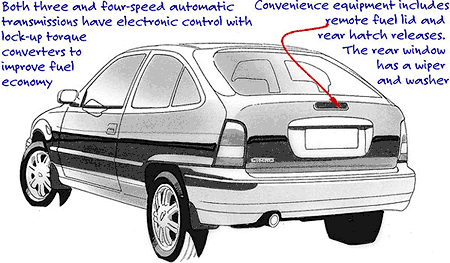
A clever marketing campaign using Cane the cattle dog, a bargain basement price and larger interior space than its rivals made it a huge sales success.
It proved there were lots of buyers who did not care that the design was dated - the 1.5i first saw the light of day as the Vauxhall Astra and Opel Kadett in Europe in the 1980s - as long as the car was affordable, dependable and cheap to run.
Daewoo's 10,000km service intervals, three-year/100,000km warranty and, from mid-1996, driveaway price with no hidden extras were icing on the cake for buyers.
The Cielo, released a year later, is an improved and restyled version of the 1.5i and maintained the sales momentum for Daewoo until the Lanos replaced it in August, 1997.
Three body styles were available - a four-door sedan and three and five-door hatchbacks.
The three-door hatch, by far the most popular, came in two equipment levels - GL and GLX.
The GL is quite well equipped for an entry level model. Standard equipment included a Phillips AM/FM radio/cassette with four speakers and intermittent wipers while power steering was originally standard but was made an option from July, 1996.
The only other options were automatic transmission and air- conditioning.
The interior space can accommodate four full-sized adults in reasonable comfort with plenty of room for luggage behind the rear seats.
The rear seat back folds down but does not have the split fold like the better equipped GLX.
The 1.5-litre, four-cylinder engine is manufactured in Australia by Holden's engine company, in keeping with the car's GM origins.
The engine is an uncomplicated design with a single overhead camshaft and two valves per cylinder which produces an adequate 55kW at 5400rpm.
The engine's strong point is low and medium-speed torque which makes it easy to drive in normal everyday driving conditions, but above 4000rpm it gets a bit coarse and noisy.
Transmissions are a five-speed manual or four-speed automatic.
Cost cutting in February, 1996, saw the four-speed replaced by a three-speed auto but this backward move cost sales.
Daewoo enlisted the help of Porsche to improve the Cielo's ride and reduce suspension noise. The result is a marked improvement over the 1.5i, although the Cielo can not be classed as a driver's car.
The suspension is still at least a generation old in design so the handling and brakes perform their functions adequately and safely without any sporting pretensions.
The narrow section, small diameter tyres do not improve the Cielo's modest road holding abilities.
The Cielo will not appeal to technophiles or the style conscious but may attract buyers who want a four-seat car which is inexpensive to buy and run.